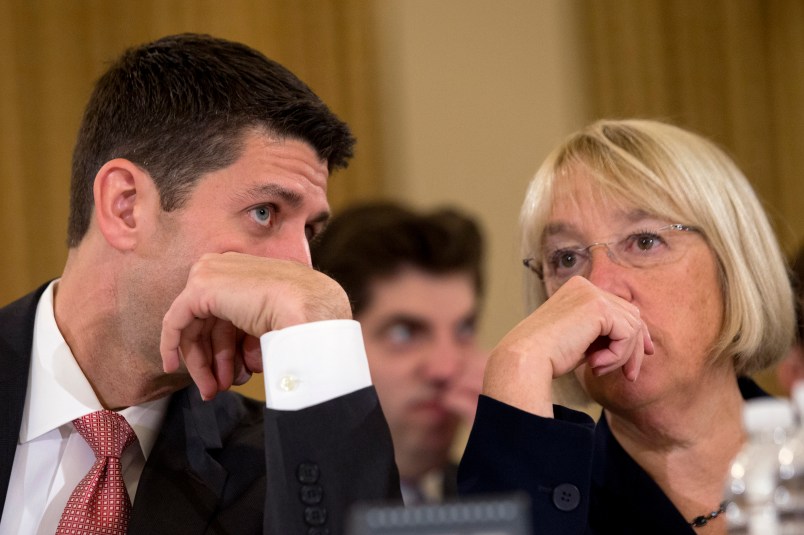WASHINGTON (AP) — A modest, bipartisan budget pact designed to keep Washington from lurching from fiscal crisis to fiscal crisis and ease the harshest effects of automatic budget cuts is on the brink of passing the Senate.
The Senate is on track to clear the bill Wednesday for President Barack Obama’s signature after a 67-33 vote Tuesday in which it easily hurdled a filibuster threshold.
The measure would restore $45 billion, half the amount scheduled to be automatically cut from the 2014 operating budgets of the Pentagon and some domestic agencies, lifting them above $1 trillion. An additional $18 billion for 2015 would provide enough relief to essentially freeze spending at those levels for the year.
The bill advanced Tuesday with the help of 12 Republicans, several of whom promised to oppose the measure in Wednesday’s final vote because it fails to take on the nation’s most pressing fiscal challenges. It would barely dent deficits that are predicted to lessen in the short term but grow larger by the end of the decade and into the next.
One provision, cutting the inflation increases of pensions for military retirees under the age of 62, was proving to be especially unpopular. Members of the military are eligible to retire after 20 years at half pay. The provision was included in the bill at the direction of House Budget Committee Chairman Paul Ryan, R-Wis.
Top Democrats said they would revisit the cut, which raises $6 billion over 10 years, before it takes effect in two years. Senate Budget Committee Chairman Patty Murray, D-Wash. — Ryan’s negotiating partner on the budget agreement — was grilled by Sen. Roger Wicker, R-Miss., on whether she knew the cut could reduce by $80,000 the lifetime benefit of a soldier who retires in his or her early 40s.
“I would suggest the senator ask that question to Chairman Ryan,” Murray said. In a document defending the cut, Ryan’s staff called pensions to middle-aged military retirees “an exceptionally generous benefit, often providing 40 years of pension payment in return for 20 years of service” and noted that “most begin a second career after leaving the military.”
“This bipartisan bill takes the first steps toward rebuilding our broken budget process. And, hopefully, toward rebuilding our broken Congress,” Murray said.
Sen. Jeanne Shaheen, D-N.H., who faces a potentially tough re-election campaign next year, promptly announced she would seek to repeal the military pension cut. The proposed pension cut has drawn howls of protest from senators with large military presences in their states.
“I promise you this. If we don’t fix it now, not only are we going to review it, we are going to fix it,” Sen. Lindsey Graham, R-S.C., said. “How could any commander in chief sign a bill that does this?”
Shaheen was joined by more than a dozen other Democrats in announcing legislation to restore the military retirement benefits and make up the money by closing a tax loophole on offshore corporations.
The bill caps a sometimes chaotic year in Washington that began with a January deal to avert a “fiscal cliff” of automatic spending cuts and expiring Bush-era tax cuts. The year also featured brinksmanship over the federal debt limit and a 16-day partial shutdown of the government sparked by Republicans in a futile attempt to curb implementation of the Affordable Care Act.
The budget agreement allows lawmakers to claim a modest accomplishment as they leave a bitterly divided Washington.
It sets the stage in January for the pragmatic-minded House and Senate Appropriations committees to draft a trillion-dollar-plus omnibus spending bill combining the 12 annual appropriations bills for the budget year that began Oct. 1. It would provide $1.012 trillion for the fiscal 2014 year already underway, a $45 billion increase over what would be required under the penalty imposed by a 2011 budget deal.
Agency budgets totaled $986 billion in 2013 after automatic cuts called sequestration were imposed, causing numerous furloughs, harming military readiness and cutting grants to local school districts, health researchers and providers of Head Start preschool care to low-income children, among numerous effects.
Due to the design of the automatic cuts, even with the boost the Pentagon still would see its non-war 2014 budget essentially frozen at 2013 levels, while domestic agencies would see an increase of about 4 percent. But those levels remain well below what was envisioned in the 2011 budget pact.
The cuts would be replaced with money from things such as higher airline security fees, a requirement that new federal workers pay more toward their pensions, the 1-percentage-point cut in the pensions of working-age military retirees and premium increases on companies whose pension plans are insured by the federal government.
Copyright 2013 The Associated Press. All rights reserved. This material may not be published, broadcast, rewritten or redistributed.






